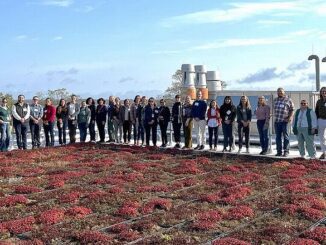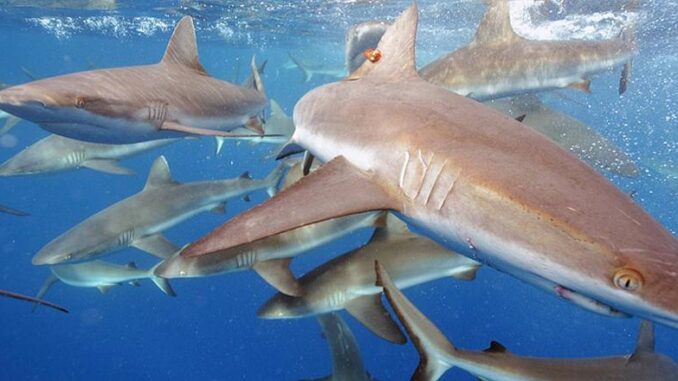
HONOLULU, Hawaii, May 29, 2025 (ENS) – Sheltering island habitats, coral reefs, and open ocean, the seven national wildlife refuges of the Pacific Islands Heritage Marine National Monument stretch across 490,000 square miles of the blue Pacific Ocean. Now President Trump wants to allow commercial fishing and Space X satellite launches in the monument.
Five times the size of all U.S. national parks combined and nearly twice the size of the state of Texas, it takes in: Baker Island, Howland Island, Jarvis Island, Johnston Atoll, Kingman Reef, Palmyra Atoll, and Wake Atoll.
Its remote location makes the Pacific Islands Heritage Marine National Monument hard to reach for the general public. Palmyra Atoll is the only one of the seven refuges that allows recreational access with a visiting vessel permit. Access to all other refuges within the monument are limited to management activities or research.
Established by President George W. Bush in 2009, the Marine National Monument was expanded five years later by President Barack Obama, who sought to preserve these fragile marine ecosystems by banning commercial fishing 50 to 200 nautical miles around Jarvis Island, Wake Island, and Johnston Atoll.
But in April, President Donald Trump signed a proclamation that seeks to strip the protections Obama added, threatening to destroy this unique web of life in favor of commercial interests.
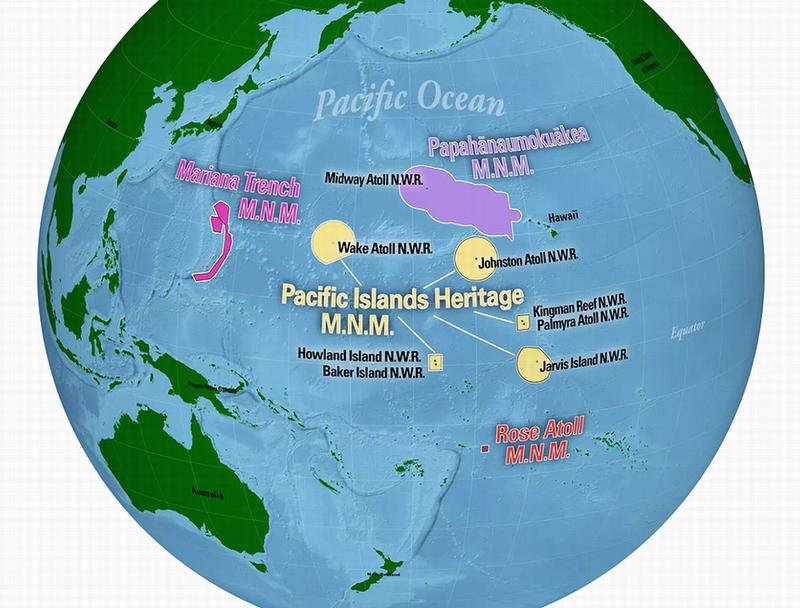
Referring to the monument by its older name, Pacific Remote Islands Marine National Monument, PRIMNM, President Trump proclaimed on April 17, “I find that appropriately managed commercial fishing would not put the objects of scientific and historic interest that the PRIMNM protects at risk.”
He said fish in the region are “effectively managed” by the National Marine Fisheries Service and the Western Pacific Regional Fishery Management Council, but that management of the monument is doing little to guard fish populations against overfishing because tunas and other pelagic species found within the monument boundaries “are migratory in nature, and do not permanently reside within the PRIMNM.”
Trump argues that, “…as a result of the prohibitions on commercial fishing, American fishing fleets have lost access to nearly half of the United States’ Exclusive Economic Zone in the Pacific Islands. This has driven American fishermen to fish further offshore in international waters to compete against poorly regulated and highly subsidized foreign fleets. This disadvantages honest United States commercial fishermen and is detrimental for United States territories like American Samoa, whose private sector economy is over 80 percent dependent on the fishing industry.”
Now a challenge to that proclamation has arisen. The public interest law firm Earthjustice, representing Kāpaʻa, the Conservation Council for Hawai‘i, and the Center for Biological Diversity, is challenging President Trump’s action as unlawful for exceeding the president’s constitutional authority and infringing upon the powers reserved to Congress.
Click here to read the legal complaint, brought in the U.S. Federal District Court in Honolulu.
In its legal filing, Earthjustice describes what would be lost if commercial fishing is allowed in the Obama expansion.
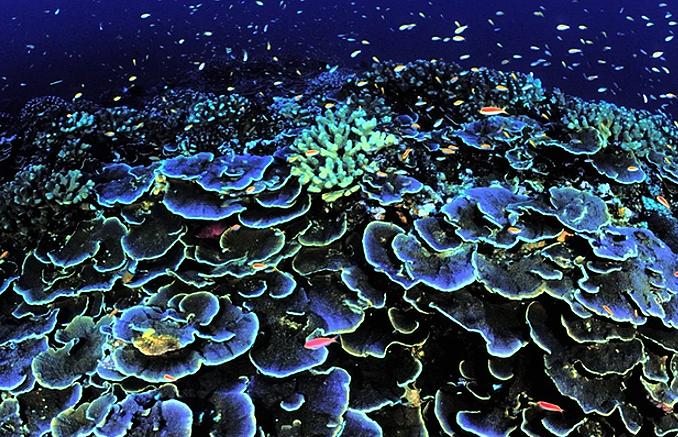
“The 2014 Proclamation reserved and protected a highly pristine deep sea and open ocean ecosystem with unique biodiversity. The Monument Expansion has more than 130 undersea mountains (called “seamounts”) that provide important opportunities for scientific exploration and study. The seamounts are home to colonies of deepwater corals many thousands of years old and for species found nowhere else on Earth, including species that are new to science.”
“Allowing commercial fishing removes large numbers of target fish and other marine animals and fish as unintended bycatch, disrupting the underwater ecosystem and food chain,” argue attorneys David Henkin and his colleagues from Earthjustice’s Honolulu office.
The reefs, seamounts, and ocean waters of the monument are filled with sharks, rays, marlin, tuna, giant clams, leatherback turtles, ancient coral forests, and whales – all sacred to the indigenous peoples of the Pacific.
Johnston Atoll is one of the oldest coral islands, called atolls, in the Pacific Ocean; it supports at least 45 coral species alongside large populations of seabirds, sea turtles, whales, and reef sharks.
Wake Atoll is believed to be the oldest living atoll in the world, where more than 300 fish species and 100 coral species thrive on the shallow coral reefs, along with giant clams, marine turtles, and spinner dolphins.
The Plaintiffs
Kāpa‘a, the Native Hawaiian Hui
The Earthjustice court filing describes the plaintiff group Kāpa‘a as a hui, or unincorporated association, of Native Hawaiian cultural practitioners, the members of which reside in Hawaii. Kāpaʻa
was formed to support the creation, protection, and expansion of marine national monuments in the Central Pacific, including the monument at issue in this case, and to oppose efforts to remove protections from these monuments.”
Opening the monument expansion to commercial fishing will harm Kāpa‘a’s members’ use and enjoyment of the monument and will continue to do so as long as commercial fishing in the Monument
Expansion is permitted,” Earthjustice argues.
Members of Kāpaʻa plan to use the lands and waters within the Monument for cultural, spiritual, religious, subsistence, recreational, educational, and aesthetic activities, including, but not limited to, voyaging canoe wayfaring, collecting natural materials used in traditional Native Hawaiian cultural practices, subsistence fishing, religious rituals and spiritual practices, and monitoring spawning seasons and distributions of marine species.
“The practice of commercial fishing and the unavoidable and significant waste of marine resources caused by commercial fishing bycatch is an affront to Kāpa‘a members’ cultural, spiritual, religious and subsistence-based beliefs. Expanding commercial fishing in the Monument Expansion to these areas prioritizes short-term gain over making the resource protection investments required to ensure abundant food from the sea for our children and our children’s children,” Earthjustice argues in its filing to the court.
Conservation Council for Hawai’i
Plaintiff Conservation Council for Hawai‘i is a non-profit citizens’ organization based in Hawai‘i with approximately 4,000 members in Hawai‘i, the United States, and foreign countries. CCH is the Hawai’i affiliate of the National Wildlife Federation, a non-profit membership organization with over 5.8 million members and supporters nationwide.
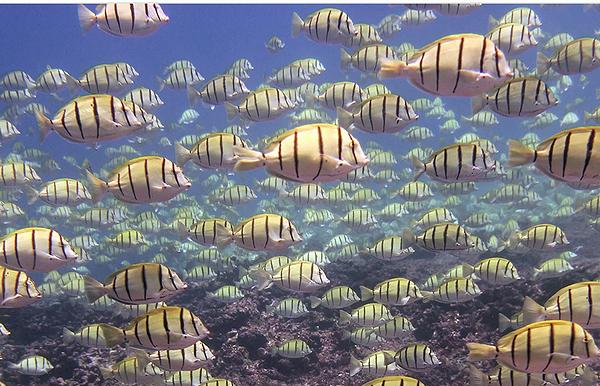
CCH’s mission is to protect Hawaii’s ecosystems and native wildlife, including threatened and endangered species, and to restore the ecosystems on which those species depend for future generations. The wildlife species that CCH has worked to protect include species of tunas, sharks, rays, whales, dolphins, seals, seabirds, sea turtles, and corals that will be harmed by allowing commercial fishing within the monument.
CCH members do scientific research on the islands in the monument. Wake Island, Jarvis Island, and Johnston Atoll have distinct, unparalleled ecological indicators for fish biomass, coral cover, and microbes, and are located along the equator, directly in line with wind and current patterns that can lead to thermal events. Because of their geographic location and pristine environments, these islands provide unique laboratories for CCH’s member and other scientists to study how coral reefs respond to and recover from thermal events,” Earthjustice argues..
The Center for Biological Diversity
The plaintiff Center for Biological Diversity is a non-profit environmental organization founded in 1989 and dedicated to the protection of native, threatened and endangered species and their habitats through science, policy, and environmental law. Incorporated in California and headquartered in Tucson, Arizona, with field offices throughout the United States and Mexico, including in Honolulu, the Center has over 90,000 members, including members in Hawai‘i and American Samoa dedicated to the protection and restoration of imperiled species and wild places.
The Center has been involved in numerous efforts to create, expand, and protect national monuments on land and sea, including the efforts to establish and expand the Monument in 2009 and 2014,
respectively. The Center has also been involved in many lawsuits and campaigns to protect the wildlife that will be harmed if commercial fishing in the monument expansion is permitted.

President Trump and Secretary of the Interior Doug Burgum have ordered a review of every mining ban and national monument on U.S. public lands seeking opportunities to reverse those bans or slash national monuments. The Center calls the policy, “a shameless ploy that would open the nation’s most cherished public lands to industry oligarchs for mining, drilling, and development.”
The monuments on the chopping block include Bears Ears in Utah; Vermilion Cliffs and Baaj Nwaavjo I’tah Kukveni – Ancestral Footprints of the Grand Canyon in Arizona; Chuckwalla, Sand to Snow, and Carrizo Plain in California; Rio Grande del Norte in New Mexico; and Avi Kwa Ame in Nevada.
“It’s the most sweeping attack on public lands in U.S. history,” the Center warns.
Center in Court Again to Save the Monument From Elon Musk
Today, the Center for Biological Diversity sued the U.S. Air Force and Fish and Wildlife Service for failing to release public records detailing the Trump administration’s plans to build landing pads for SpaceX rockets in the sensitive habitat of Pacific Islands Heritage Marine National Monument
In March, the U.S. Air Force announced plans to begin reviewing the potential environmental harms of landing dozens of commercial rockets in the Johnston Atoll National Wildlife Refuge, which lies within the protected monument. This project is part of an Air Force program called Rocket Cargo Vanguard intended to experiment with the use of commercial rockets for military logistics and materiel transport.
“Landing massive rockets in one of the most isolated and valuable habitats for seabirds would be as destructive and irresponsible as it sounds. That’s exactly why the military and SpaceX are trying to keep this project’s details hidden from the public,” said Maxx Phillips, Hawai‘i and Pacific Islands director at the Center. “This project threatens to destroy a site that millions of seabirds need for nesting and overwintering, all in the name of military logistics and Elon Musk’s profit.”
The Johnston Atoll National Wildlife Refuge and the surrounding Pacific Islands Heritage Marine National Monument protect vital nesting habitat for seabirds, shallow coral reefs and marine habitat for endangered species like green sea turtles and Hawaiian monk seals.
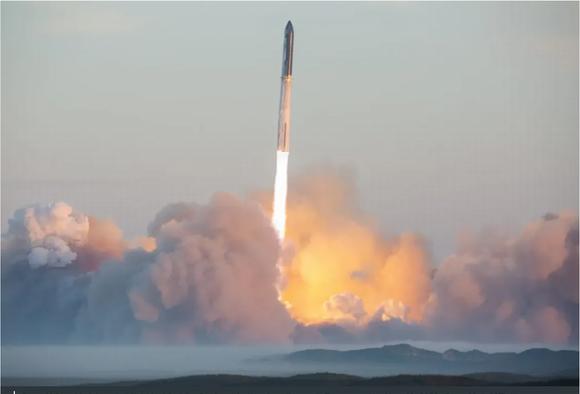
This plan would allow SpaceX and the U.S. Space Force to land up to 10 rockets per year over the next four years on Johnston Atoll.
First designated as a refuge for native birds in 1926, Johnston Atoll was later desecrated by the testing of nuclear weapons, the stockpiling of Agent Orange and the disposal of chemical weapons.
The military left in 2004 after removing most buildings and closing the airstrip.
Now the military is preparing a shortened version of an environmental analysis required by the National Environmental Policy Act to assess potential harms from the project, including the harms that rocket landings could have on fish habitat and migratory birds.
The Center argues that there is “a history of inadequate environmental review and recurring harm to sensitive and ecologically critical habitat on national wildlife refuge lands from SpaceX’s activities, including several explosions.”
In April the Center submitted a Freedom of Information Act request for public records documenting the Trump administration’s plans to construct and operate the two Johnston Atoll landing pads. The requested records would help the public understand the project’s scope and whether the government’s environmental study adequately examines the project’s risks.
Featured image: Grey reef sharks at the Pacific Islands Heritage Marine National Monument. (Photo by Kydd Pollock/U.S. Fish & Wildlife Service)
© 2025, Environment News Service. All rights reserved. Content may be quoted only with proper attribution and a direct link to the original article. Full reproduction is prohibited.

